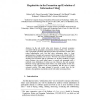Free Online Productivity Tools
i2Speak
i2Symbol
i2OCR
iTex2Img
iWeb2Print
iWeb2Shot
i2Type
iPdf2Split
iPdf2Merge
i2Bopomofo
i2Arabic
i2Style
i2Image
i2PDF
iLatex2Rtf
Sci2ools
DIGITALCITIES
2001
Springer
2001
Springer
Regularities in the Formation and Evolution of Information Cities
In the real world, cities exist because of external economies associated with the geographic concentration of firms within a city. Of course, such a geographic proximity with input providers and consumers, would at first reduce transportation costs. But why cities, information cities, i.e. large agglomerations of people and economic activity emerge in the virtual world? In the Internet, transportation costs are zero. Web sites can easily be reached from anybody and everywhere with no particular cost. In these conditions of equal access distance, one would rather expect a smooth web geography with a relatively even distribution of visitors per site. However, the web economy illustrates strong agglomeration trends with a very small number of web sites capturing a large segment of the web population and the most of virtual economic activity. This paper attempts to provide a sound basis for the dynamics of population concentration in the web under increasing returns.
| Added | 28 Jul 2010 |
| Updated | 28 Jul 2010 |
| Type | Conference |
| Year | 2001 |
| Where | DIGITALCITIES |
| Authors | Stelios Lelis, Petros Kavassalis, Jakka Sairamesh, Seif Haridi, Fredrik Holmgren, Mahmoud Rafea, Antonis Hatzistamatiou |
Comments (0)

